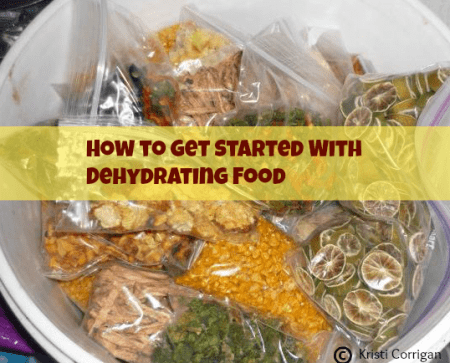If you have never dehydrated food, you will want to keep reading! Dehydrating your food is great for saving money, space and preserving food that would otherwise go bad. I’m sure to most people the thought of dehydrating food sounds a little intimidating. However, it is extremely easy to do and it’s also fun.
You can dehydrate just about anything you can think of! Dehydrating food is also less intimidating than canning food.
Tips on Dehydrating Food
Supplies Needed
- A Dehydrator. You don’t need to run out and purchase an expensive dehydrator. I own a dehydrator made byNesco
and it does the trick. I have yet to have any issues with my dehydrator. - A Good Knife. You will want to have a good knife for cutting up the foods that you are dehydrating.
- Spatula. I suggest having a few spatulas on hand. You will use the spatula to lift food of the trays.
- Oxygen Absorber Packs. You can find oxygen absorber packs
on Amazon or any camping supply store. These are not necessary to have but they do come in handy. If you store your food in a mason jar, add in one oxygen pack to suck out the air.
- Vacuum Sealer
. Once again this is not necessary but it is handy to ensure that all the air is out of your storage bags.
As you can see it doesn’t take much to get started with dehydrating your own food.
Preparation
- In order to successfully dehydrate food, you will want to make sure your food is fresh and of good quality.
- Slice all of your food to the same size. Doing this will help your food dehydrate at the same rate.
- It is not necessary but you can dip apples or any other fruit that tends to brown in cold water and lemon juice.
Once you have prepped your food you are ready to start the dehydration process.
How to Dehydrate the Food
This part is extremely simple! You will lay out all of your food on the dehydrating trays that came with your dehydrator. Try to ensure everything is evenly spread out. You will then check the manufactures guide to see what temperature to set your dehydrator at. Your manufactures guide will also tell you how long to dehydrate the food.
Once you have the food in and the temperature set, walk away! It is really that simple!
Once your food is dehydrated you will want to let it cool and then package it in air-tight containers.
How Long Does Dehydrated Food Last
The answer to this will vary from person to person. Some people say that you can keep dehydrated food for years. I am with the school of thought that you should use your food within a year. Since the answer to this does vary so much you will have to decide what you are comfortable with.
What Can You Dehydrate
The list of what you can dehydrate is endless. The items listed below are only some of the things you can dehydrate. If you think of something just Google it and you will get an answer! Let your imagination run wild.
- Fruits & Vegetables
- Meat & Fish
- Herbs
- Bread (To make breadcrumbs)
- Pasta
- Tomato Sauce
- Fresh Pasta
- You can also make your own fruit roll ups!
As you can see you can make dehydrate so many different things. I do suggest starting off with simple items like apples, strawberries, bananas and vegetables.
Rehydrating Food
Rehydrating your food is actually very simple. You can add dehydrated veggies while cooking your stew or soup. You can eat dehydrated fruits without rehydrating them. The most traditional way to rehydrate your food is to add the dehydrated food to cold water. You can also use warm water to speed up the process. Your manufactures guide will usually go over this process as well.
Tips
- When dehydrating garlic or onion, place your dehydrator outside! This will prevent your house from smelling like onion or garlic.
- Humidity will work against you. Try not to dehydrate food on a humid day.
- Dehydrating food is trial and error. It might take a few times to get it just right.
- Add cinnamon or sugar to your apples to make a tasty snack.
- Cook potatoes before dehydrating them to prevent them from turning black.
More Ways to Preserve Food:


Deborah says
Kristi, I’ve been dehydrating for several years now. One thing . . . If you are dehydrating fresh veggies, you do need to blanch them for about 5 minutes. I have some home canned foods that are about to expire, and am planning on dehydrating them soon. As for dehydrating onions and garlic, I like the smell. LOL its best to do this in the summer so you can open the house. I’m planning a garden for this spring, and am wanting to dehydrate as much as possible. I also want to make some veggie powders.
Adrian says
Hey Kristi – fancy meeting you here. I’m a huge SITS girl fan (been to 3 of their conferences) and I just happened to pop over here because I just bought a dehydrater and I’m trying to figure out how to use it. Small world!
Jean | DelightfulRepast.com says
Kristi, I’ve never done much dehydrating; but I may yet. My parents did a lot of dehydrating, even making their own beef jerky that was vastly superior to any you can buy. Several years ago my dad offered me his dehydrator before he gave it away. I’ve regretted not taking it! I just added your blog to my Blogs I Visit page.
Salixisme says
I do a lot of dehydrating – everything from fruit and veggies to meat and fish jerkeys.
And yes I do make fruit rollups…
If I ever make too much smoothie to fit in the glass I put it in the dehydrator…. leftover smoothies make the BEST fruit leather/fruit rollups!